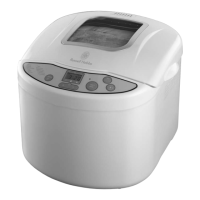sandwich
This program provides a loaf with a loose texture and a thin crust, ideal for making sandwiches.
gluten free
Gluten free bread uses other substances to give the dough elasticity and bounce. Gluten free
loaves tend to be denser and coarser than bread made with strong flour.
Our baker prefers Juvela® (www.juvela.co.uk) gluten-free bread mix – N.B. this is gluten-free, not
wheat-free – it’s available from pharmacists.
fastbake I and II
The are variations on the basic program, with reduced kneading, rising, and baking times.
for they cut the program times to 55 and 80 minutes respectively
against because of this, your bread will be smaller, denser, and coarser than normal, and any
additional ingredients (raisins, nuts, etc.) may be mashed, or unevenly distributed
speciality
This program is specially designed for the malt loaf recipe.
ingredients
flour
The type of flour used is important. You can’t use “ordinary” plain flour for making bread. Buy
flour with “strong” or “bread” in its title. The commonest is normally marketed as strong white
flour. These “strong” or “bread” flours contain more gluten than ordinary baking flour. Gluten is
the protein that gives the bread its structure and texture. It retains the carbon dioxide produced
by the yeast, putting the elasticity, the bounce, into the dough.
other bread flours
These include strong brown or “Farmhouse” flour, strong wholemeal, and whole wheat bread
making flours. These provide an excellent source of dietary fibre, but contain lower levels of
gluten than strong white flour. This means that brown loaves tend to be smaller and denser than
white loaves. Generally speaking, if you substitute strong white flour for half of the brown flour
in the recipe, you can make bread with a “brown bread” flavour and a “white bread” texture.
yeast
1 Yeast is a living organism. Given moisture, food, and warmth, the yeast will grow and release
carbon dioxide gas. The carbon dioxide forms bubbles which are trapped in the dough,
making it rise.
2 Of the various types of yeast available, we recommend using “dried active yeast”, also known
as “dry active yeast”, and “instant yeast” or “easy blend dried yeast”. These are usually sold in
7 gram sachets and don’t have to be dissolved in water first.
3 If you don’t use all the yeast in a sachet, throw it away, don’t save it – it’ll go stale.
4 Don’t use fresh or tinned yeast – they won’t work properly with your breadmaker.
5 Check the “best before” date on the sachet of yeast – if it’s approaching its “best before” date,
don’t take any chances – throw it out and buy some more.
6 You may also see “fast action’ or “bread machine” yeast – really potent yeasts that can make
dough rise up to 50% faster. If you want to use these, you’ll need to do a bit of experimenting
to get the best results. You could start off by trying them with the fastbake programs.
liquid
1 The liquid ingredient is normally water or milk, or a mixture of the two.
2 Water makes a crispier crust. Milk gives a softer crust with a velvety texture.
3 The liquid should be warm, not hot or cold. Both hot and cold water will inhibit the yeast.
4 Some recipes call for hand-hot water (that’s 35°C-50°C/95°F-122°F), to speed up the process.
Only the fast yeasts can handle this temperature.
5 Don’t use milk with the timer; it might curdle before the bread-making process starts.

